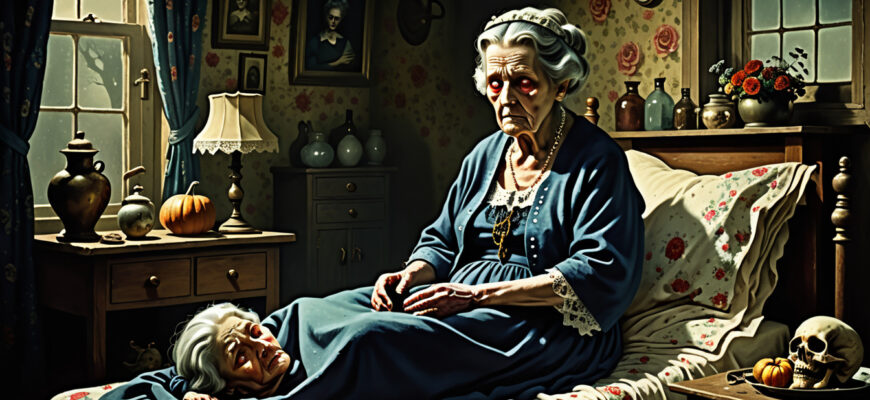Dreams featuring a deceased grandmother often arrive with a mix of comfort, challenge, and invitation. They don’t just replay memories, but tap into something deeper—offering spaces where grief and healing intertwine, while ancestral presence gently steps through the veil. These visitations might leave you wondering about unresolved feelings, family histories, or hidden support. For many, especially those navigating queer or chosen-family paths, such dreams carry extra layers of meaning: reminders that family transcends biology and that love’s roots run wide and wild.
- The Meaning Behind Dreams Of A Deceased Grandmother
- Recognizing The Different Appearances And Messages
- Dreams As An Invitation To Inner Dialogue And Reflection
- Emotional Healing Through Ancestral Presence in Dreams
- Spiritual Connection and Personal Transformation
- How Chosen Families Experience Ancestral Dreams Differently
The Meaning Behind Dreams Of A Deceased Grandmother
Grief doesn’t always follow a linear path, and dreams can be one of the ways the heart moves toward healing. When a grandmother appears in dreams after passing, it often stirs up emotions left unspoken or underscored in waking life. It might surface longing for her warmth or a chance to say goodbye. These dreams provide a safe place to process complicated feelings, helping soothe loss and build bridges to peace.
Beyond emotional echoes, these dreams often carry a spiritual weight. Many traditions view a dead grandmother’s presence as a sign she’s close by in the ancestral realm—watching, protecting, or guiding. This connection transcends time and space, inviting us to feel tied to a lineage that nourishes and supports even when the physical form is gone. In this way, dreams can become sacred meetings, where wisdom flows down from generations past.
Sometimes, the dream shines light on family roots or unresolved stories. It may ask us to reckon with history or ancestral patterns we haven’t yet faced—whether that’s unspoken grief, long-held family beliefs, or old wounds asking for attention. These nocturnal messages can prompt reflection on what parts of our lineage we carry, heal, or release.
Looking through a queer and chosen-family lens enriches this experience. For people whose relationships don’t follow traditional bloodlines, these dreams can affirm that ancestry and family are about love and chosen bonds, too. The grandmother figure then acts as a symbol of protection and belonging beyond genetic ties—calling on us to reclaim legacies of nurturing and resilience on our terms.
Recognizing The Different Appearances And Messages
How a grandmother shows up in a dream colors its meaning. A warm, smiling figure often brings a sense of reassurance, reminding us that support is near and healing is possible. It might feel like a loving hug folded into sleep, signaling you’re being held even in tough moments.
On the flip side, if the grandmother appears concerned or serious, it can be a nudge to pause and reflect. Maybe something needs your attention—a choice, a relationship, or a way of caring for yourself. Sometimes this mood signals a warning, not to scare but to open eyes and hearts to what needs tending.
Reading the tone and atmosphere is key. Is the dream cozy or tense? Bright or shadowed? These details act like an emotional compass, guiding you toward the dream’s purpose. The messages might be symbolic rather than literal—less a haunting, more a meaningful symbol asking you to listen.
| Dream Appearance | Possible Meaning | Emotional Tone |
|---|---|---|
| Warm, Smiling Grandmother | Comfort, Reassurance, Support | Gentle, Loving |
| Concerned or Serious Grandmother | Reflection, Warning, Call to Action | Serious, Thoughtful |
| Angry or Distressed Grandmother | Alert to Neglected Issues, Emotional Challenge | Unsettling, Urgent |
| Silent or Distant Grandmother | Unresolved Feelings, Need for Connection | Melancholy, Longing |
Holding space for the feelings these dreams bring is part of their power. Whether you wake comforted or unsettled, honoring your emotional reaction helps the messages unfold in healing ways. Sometimes writing, sharing with trusted friends, or sitting quietly with the feelings helps carry this work out of dreams and into waking life.
Dreams As An Invitation To Inner Dialogue And Reflection
These dreams often leave us with questions that linger, inviting a slow, tender inner conversation. What does her presence say about your relationship with family and legacy? Are there parts of yourself craving care or attention? The dreams create a gateway to wisdom waiting just beneath the surface.
The space they open can hold both grief and love at once—a gentle balancing act that honors loss while embracing connection. This invitation isn’t just about mourning but about embracing ancestral care as part of your nurturing practice.
See these encounters as soulful check-ins—moments that ask you to pause, breathe, and meet your feelings without rush. They can be an act of self-awareness, reminding you: you were born for this. Embracing the dream as a portal to healing and insight grounds you in your story and guides you forward with deeper heart knowledge.
- What feelings arose when you saw her?
- Did the dream bring clarity or questions?
- Which parts of your life feel touched by her message?
Emotional Healing Through Ancestral Presence in Dreams
How do dreams of a grandmother who’s passed on offer comfort when grief feels too heavy? These nighttime visits often arrive like a soft whisper during turbulent emotional storms, easing the raw edges of loss with gentle care. When grief work is accompanied by such a tender dream figure, something shifts — the ache of absence is met with warmth, a feeling that healing is allowed, safe, and ongoing.
Inherited trauma weaves into family trees like quiet undercurrents, and ancestral dream figures—especially grandmothers—offer presence that invites release. These nocturnal encounters might bring messages or feelings that hold ancestral teachings: lessons about resilience, forgiveness, or the wisdom embedded in survival. What’s more, they help break patterns of pain passed down through generations, offering permission to embrace healing and step into new emotional freedom.
Familial wounds sometimes feel carved in stone, but dreams can serve as a balm, softening those hardened places fresh wounds once cemented in silence and misunderstanding. In dreams, grandmothers might embrace, hold hands, or simply appear with knowing smiles, carrying a silent assurance that brokenness will mend. Such images create a safe space where difficult family dynamics are met with compassion instead of judgment, giving heart and soul permission to breathe.
Capturing what surfaces during these dream encounters has a potent power:
- Journaling immediately upon waking can unearth hidden emotions and insights—record fragments, feelings, or direct messages.
- Meditative reflection invites sitting quietly with the dream imagery, allowing it to deepen understanding beyond surface meaning.
- Asking gentle questions like “What is this dream asking me to notice about myself or my family?” or “What comfort or guidance did she offer?” can be especially grounding.
Using these tools creates a bridge between night visions and waking life, transforming fleeting dreams into ongoing sources of emotional nourishment and inherited wisdom.
Spiritual Connection and Personal Transformation
What if dreams are not just random images but actual doorways to something deeper—spiritual guidance that arrives when life feels uncertain or fractured? Recognizing these moments as gateways allows for a clearer reception of ancestral wisdom and cosmic reassurance. When a grandmother’s spirit visits, it often feels like crossing thresholds where time, space, and lineage fold into one intimate conversation.
Ritual, prayer, or intention-setting can align waking actions with the profound messages from these dream visits. Lighting a candle, creating an altar, or simply setting a quiet intention before sleep invites reverence for the encounter, making the spiritual communication part of daily life. It anchors dream lessons, planting them firmly in the body and mind.
This process nurtures parts of the self left wanting—maybe the inner child longing for safety or the wise self needing encouragement. The transformation unfolds gently, shifting how you relate to your history, your choices, and your capacity to heal. These dreams become an ongoing dialogue with unseen realms, a cosmic conversation that crosses generations and dimensions.
Seen through a queer and feminist lens, these ancestral dreams reclaim legacies far beyond biology. They celebrate chosen families, radical love, and heritage shaped by spirit and intention. The words “You were born for this” resonate here as an invitation to own the power of ancestral love not as burden but as liberation—a force to help realign, reclaim, and heal.
How Chosen Families Experience Ancestral Dreams Differently
Chosen families reframe what it means to belong, rooting kinship in shared values, mutual care, and intentional bonds rather than blood alone. For many queer seekers, ancestral dreams become anchors of love and protection that transcend DNA, affirming spiritual kinship that feels profoundly real.
These dreams stitch together a tapestry of legacy that’s vibrant with intention—connected not just by genetics but by the fierce choice to hold and nurture one another. They invite remembering that family is as expansive as the heart and spirit, offering a sense of belonging that defies traditional frameworks.








